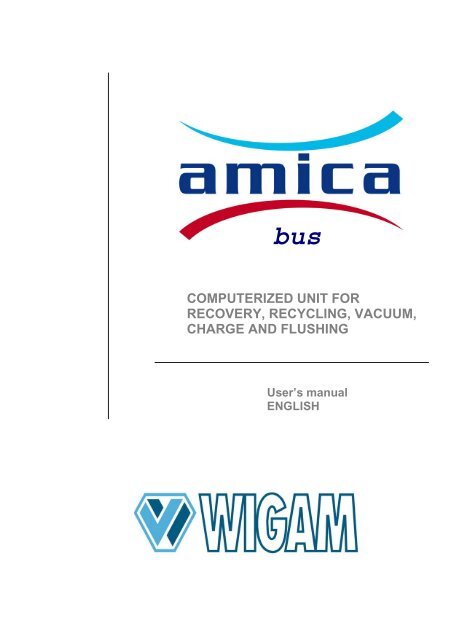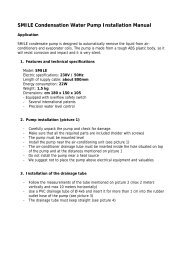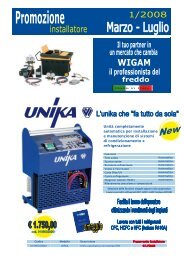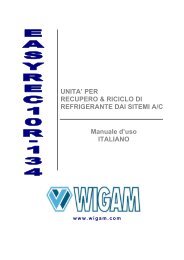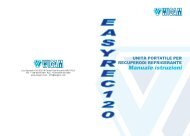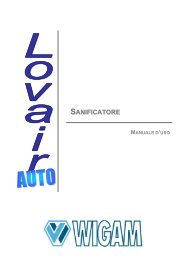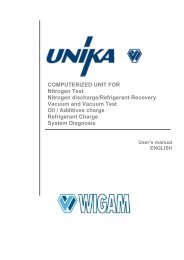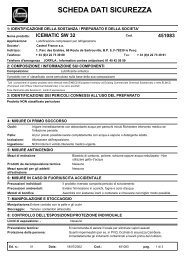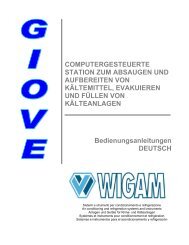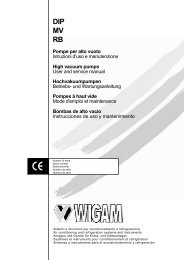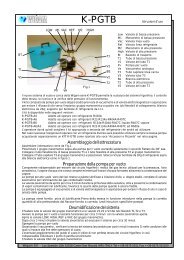computerized unit for recovery, recycling, vacuum, charge - Wigam
computerized unit for recovery, recycling, vacuum, charge - Wigam
computerized unit for recovery, recycling, vacuum, charge - Wigam
- No tags were found...
Create successful ePaper yourself
Turn your PDF publications into a flip-book with our unique Google optimized e-Paper software.
usCOMPUTERIZED UNIT FORRECOVERY, RECYCLING, VACUUM,CHARGE AND FLUSHINGEUser’s manualENGLISH
ITALIANENGLISH<strong>Wigam</strong> spa reserves the right todiscontinue, or change at anytime specifications or designswithout notice and withoutincurring obligations accordingto her policy of alwaysimproving her products.Layout: WIGAM SPAPrinted in ItalySecond edition: January 20072
ITALIANENGLISHCONTENTSSafety precautions..................................................................................................................5Layout drawing .......................................................................................................................6Electric scheme ....................................................................................................................10Legend...................................................................................................................................111. Introduction to AMICA/BUS <strong>recovery</strong> <strong>unit</strong>...................................................................131.1 Technical specifications ....................................................................................................................... 132. Components description and standard equipment ....................................................132.1 High <strong>vacuum</strong> pump .............................................................................................................................. 132.2 Refrigerant bottle.................................................................................................................................. 132.3 Distiller - separator ............................................................................................................................... 132.4 Compressor.......................................................................................................................................... 142.5 Filters.................................................................................................................................................... 142.6 Flexible hoses ...................................................................................................................................... 142.7 Quick coupler valves ............................................................................................................................ 142.8 Printer................................................................................................................................................... 142.9 Temperature probe............................................................................................................................... 142.10 Control module ..................................................................................................................................... 142.11 Functions programming........................................................................................................................ 142.12 Functions that can be per<strong>for</strong>med ......................................................................................................... 153. Control panel .................................................................................................................163.1 Description of the control keys ............................................................................................................. 164. Preparing the <strong>unit</strong> AMICA/BUS <strong>for</strong> operation ..........................................................174.1 Checking the <strong>vacuum</strong> pump oil level.................................................................................................... 174.2 Unlocking the scale .............................................................................................................................. 174.3 "Zero" scale check................................................................................................................................ 184.4 Filling refrigerant into the bottle............................................................................................................ 184.4.1 Filling refrigerant into the internal bottle by means of <strong>recovery</strong> from the service bottle....................... 184.4.2 Emptying the internal bottle.................................................................................................................. 205. Recovery ........................................................................................................................215.1 Preparing the vehicle <strong>for</strong> refrigerant <strong>recovery</strong> from the A/C system .................................................... 215.2 Refrigerant <strong>recovery</strong> <strong>for</strong> R= all ............................................................................................................. 215.3 Refrigerant <strong>recovery</strong> <strong>for</strong> R00.00....................................................................................................... 226. Draining of the oil extracted from the A/C system......................................................237. Evacuating and checking the A/C system <strong>for</strong> tightness ............................................238. Refilling oil into the A/C system...................................................................................248.1 Warning ................................................................................................................................................ 248.2 Warning ................................................................................................................................................ 248.3 Oil refilling procedure in the A/C system .............................................................................................. 248.4 Suggested oil quantities <strong>for</strong> refilling the vehicle air conditioner ........................................................... 258.5 Warning ................................................................................................................................................ 258.6 UV refilling procedure in the A/C system ............................................................................................. 259. Charging refrigerant into the A/C system................................................................269.1 Warning ................................................................................................................................................ 269.2 A/C system refrigerant charging procedure ......................................................................................... 2610. Checking the A/C system operating pressures.......................................................2611. FLUSHING automatic function..................................................................................2712. FIRE&GO automatic function....................................................................................2713. AUTO function............................................................................................................2814. Operations be<strong>for</strong>e disconnecting the <strong>unit</strong> from the A/C system ...........................283
ITALIANENGLISH15. Routine maintenance.................................................................................................2915.1 Material <strong>for</strong> routine maintenance.......................................................................................................... 2915.2 Periodic operations............................................................................................................................... 2915.3 Changing the <strong>vacuum</strong> pump oil............................................................................................................ 2915.4 Replacing the filter driers...................................................................................................................... 3016. Accessories and spare parts ....................................................................................3117. Dimensions and weight .............................................................................................314
ITALIANENGLISHWARNINGSafety precautionsa) This equipment is designed <strong>for</strong> trained personnel only, who must know therefrigeration fundamentals, cooling systems, refrigerants andpossible damage that pressurized equipment may cause.b) Carefully read the instructions contained in this manual; strictobservance of the procedures described is fundamental to the operator’ssafety, the perfect state of the <strong>unit</strong> and constant per<strong>for</strong>mances asdeclared.c) Do not operate the <strong>unit</strong> with different refrigerant than the one it hasbeen designed <strong>for</strong>.d) Be<strong>for</strong>e per<strong>for</strong>ming any operation, make sure that the hoses used <strong>for</strong>connections have been previously evacuated and that they do notcontain non-condensable gases.e) Avoid skin contact; the low boiling temperature of the refrigerant (about -30°C)can cause freezing.f) Avoid breathing refrigerant vapours.g) It is recommended to wear suitable protections like safety glasses andgloves; contact with refrigerant may cause blindness and other personalinjuries.h) Do not operate near open flames and hot surfaces; the high temperaturesdecompose the refrigerant releasing toxic and caustic substances whichare hazardous <strong>for</strong> the operator and the environment.i) Always make sure that the <strong>unit</strong> is connected to a suitably protected mainssupply provided with an efficient earth connection.j) Be<strong>for</strong>e per<strong>for</strong>ming maintenance operations or when the <strong>unit</strong> will not be used<strong>for</strong> a long period of time, turn the <strong>unit</strong> off by turning the main switch to 0and disconnect the power supply cord; absolutely follow thesequence of operations.k) Operate the <strong>unit</strong> only in locations with suitable ventilation and a highnumber of air changes.l) Be<strong>for</strong>e disconnecting the <strong>unit</strong>, make sure that the cycle has beencompleted and that all valves are closed in order to avoid release ofrefrigerant to the atmosphere.m) Never fill any tank with liquid refrigerant to more than 75% of its maximumcapacity.n) During operations avoid release of refrigerant to the environment; thisprecaution is required by international environmental standards and is essential to avoiddifficult leak detection in a refrigerant polluted environment.o) The equipment must always work under the operator’s control.p) Protect the <strong>unit</strong> from dripping.q) Do not modify the calibration of safety valves and control systems.r) If you recover refrigerant from a cooling system equipped with a waterevaporator and/or condenser, it is necessary to drain water from theevaporator and/or condenser or to keep the circulation pump runningduring the entire <strong>recovery</strong> operation in order to avoid frosting.5
ITALIANENGLISHLayout drawing6
ITALIANENGLISH7
ITALIANENGLISH8
ITALIANENGLISHHydraulic diagram9
ITALIANENGLISHElectric scheme10
ITALIANENGLISHLegend1 - EV1 Solenoid valve - oil draining line 1 57 - S2 Bottle service connection - liquid phase2 - EV2 Solenoid valve - <strong>recovery</strong> line 1 58 Distiller – line 13 - EV3 Solenoid valve – UV charging line 59 Up and Down keys4 - EV4 Solenoid valve – <strong>vacuum</strong> pump suction line 60 Memory card5 - R5 Heating element RSF100 - line 1 61 - F1 Filter drier - line 16 Vacuum pump 62 - F2 Filter drier - line 17 Recovery compressor – line 1 63 - F21 Filter drier - line 28 Fan – line 1 64 - F22 Filter drier - line 29 - V9 Manual oil dis<strong>charge</strong> – line 1 65 - V1 Valve on LP service hose10 - EV10 Vacuum pump suction valve – VACUUM TEST 66 -V2 Valve on HP service hose11 Refrigerant bottle 67 - T1 Low pressure service hose12 Warning light 68 - T2 High pressure service hose13 - EV13 Solenoid valve – refrigerant <strong>charge</strong> 69 - PWR Power switch14 - R14 Heating element RSF 400 70 - VS Safety valve – non condensable gases15 Adjustable pressure/<strong>vacuum</strong> switch 71 - LOW Low pressure valve16 Floater - line 1 72 - HIGH High pressure valve17 Safety pressure switch 73 - M1 Low pressure gauge18 Vacuum switch 74 - M2 High pressure gauge19 - EV19 Solenoid valve – oil charging line 75 - M3 Refrigerant bottle pressure gauge20 - EV20 Solenoid valve – oil return line 1 to compressor 76 Enter key21 - EV21 Solenoid valve – oil draining line 2 77 Menu key22 -EV22 Solenoid valve – <strong>recovery</strong> line 2 78 Distiller – line 223 - V23 Bottle valve – vapour phase 79 Stop key24 - V24 Service bottle valve 80 Capillary tube – oil <strong>charge</strong>25 - R25 Heating element RSF100 - line 2 81 Capillary tube –UV <strong>charge</strong>26 Floater – line 2 82 Vacuum pump suction hose27 Recovery compressor – line 2 83 Manifold / Valve assembly connectinghose28 Fan - line 2 84 Valve assembly – Distiller 1 connectinghose29 -V29 Manual oil dis<strong>charge</strong> – line 2 85 Valve assembly / Distiller 2 connectinghose30 Display 86 Capillary tube – pressure/<strong>vacuum</strong> switch31 - CV1 Check valve - suction line 1 87 Capillary tube – Bottle32 - CV2 Check valve - compressor delivery line 1 88 Liquid side bottle connecting hose33 - CV3 Check valve - refrigerant charging line 89 -(1-2) Capillary tube – oil dis<strong>charge</strong>34 - CV4 Check valve - oil draining line 1 90 PWR35 - CV5 Check valve - Oil charging line 91 Distiller / condenser line 1 hose36 - CV6 Check valve - UV charging line 92 Rear wheel with brake37 Oil separator - compressor 1 93 Central wheel38 Oil separator - compressor 2 94 Front rotating wheel39 Control panel 95 Compressor line 2 suction hose40 - EV40 Solenoid valve – oil return line 2 to compressor 96 Compressor line 1 suction hose41 - CV21 Check valve – suction line 2 97 Distiller / Filter line 1 connecting hose42 - CV22 Check valve – compressor delivery line 2 98 Function keys43 Paper 99 Condensers / Bottle connecting hose44 - CV24 Check valve - oil draining line 2 100 - S3 Bottle service connection - vapourphase45 - PRT Printer 101 Vacuum pump filler plug46 Feed key 102 Vacuum pump sight glass47 Alphanumeric keyboard 103 Vacuum pump oil drain plug11
ITALIANENGLISH48 Oil drain bottle 104 Distiller / Filter line 2 connecting hose49 UV dosimeter 105 Temperature probe50 Oil dosimeter 106 Distiller / Condenser hose on line 251 Heating element RSF 400 switch 107 Electric cable52 - CEL1 UV injection load cell - 5kg 108 -(1-2) Condenser / Bottle connecting hose53 - CEL2 OIL injection load cell – 5kg 109 Condenser - line 154 - CEL3 OIL drain load cell – 5kg 110 Condenser – line 255 - CEL4 REFRIGERANT load cell - 100kg 111 Basin56 - S1 Compressor service connection12
ITALIANENGLISH1. Introduction to AMICA/BUS <strong>recovery</strong> <strong>unit</strong>AMICA/BUS <strong>unit</strong> permits quick and efficient <strong>recovery</strong> of refrigerant from the A/C system, refrigerant<strong>recycling</strong>, system evacuation, check <strong>for</strong> tightness, additive or lubricant injection, the subsequent <strong>charge</strong>with refrigerant, measurement of the operating pressures.AMICA/BUS <strong>unit</strong> permits the control of all the functions by means of 4 electronic scales, which controlrespectively: oil dis<strong>charge</strong>d from the A/C system, refrigerant <strong>charge</strong>, oil <strong>charge</strong> and additive <strong>charge</strong>.1.1 TECHNICAL SPECIFICATIONSAMICA/BUS modelR134a refrigerantMaximum storage capacity40 kgRefrigerant reserve4 kgMaximum <strong>recovery</strong> rate0,8 kg/minOil maximum capacity500 gOil reserve50 gAdditive maximum capacity200 gAdditive reserve30 gPower supply 230/1/50Power input1400 WStorage temperature -10 ÷ +50 °CAmbient temperature 0 ÷ 40 °CDegree of protectionIP24Noise level< 70dB (A)Maximum refrigerant <strong>charge</strong>The maximum refrigerant quantity available <strong>for</strong> charging is calculated by subtracting 4 kg fromthe weight of the refrigerant contained in the bottle and indicated on the displaymax kg <strong>for</strong> charging = kg in bottle - 4 kgModelAMICA/BUSConnections3/8” sae with quick coupler valves2. Components description and standard equipment2.1 HIGH VACUUM PUMPEssential component <strong>for</strong> extracting from the cooling system the residues of technical gases used <strong>for</strong>pressing, ambient air and vapour contained in it as well as water possibly <strong>for</strong>med through vapourcondensation.The high <strong>vacuum</strong> pump the <strong>unit</strong> is equipped with is rotary vane type, lubricated by oil injection. It is dualstage and has a swept volume of 180l/min.2.2 REFRIGERANT BOTTLEMaximum capacity kg 40Weight of empty bottle kg 19It is provided with two connections, one of which with tube (liquid refrigerant) and one without tube(vapour refrigerant), safety valve, non-condensable gas purge and heater belt with thermostat.2.3 DISTILLER - SEPARATORSingle body construction, featuring:- distillation chamber with automatic flow control- separating chamber <strong>for</strong> the oil removed from compressor, provided with a device <strong>for</strong> automatic return atthe end of the cycle- heat exchanger chamber outlet gas / recovered refrigerant13
ITALIANENGLISH2.4 COMPRESSORThe compressor is of the hermetic type.2.5 FILTERSEach anti-acid filter drier has a water absorption capacity of 40 g.2.6 FLEXIBLE HOSESTheir flexibility assures easy connection in any situation. They withstand A/C system operatingpressures and maintain their passage section even when operating in <strong>vacuum</strong>.AMICA/BUS <strong>unit</strong> features hoses with quick coupler valves.2.7 QUICK COUPLER VALVESMounted on the hose ends and provided with a coloured operating ring (blue = low pressure, ref. V1; red= high pressure, ref. V2) <strong>for</strong> quick identification.2.8 PRINTERThe printer allows to print on standard paper with a chart size of 57mm width a report with the valuesprogrammed by the operator and executed by the <strong>unit</strong>, with the possibility to re-print the report.2.9 TEMPERATURE PROBEThe <strong>unit</strong> is equipped with a temperature probe (with range from -10°C to +50°C), which allows to checkthe ambient temperature at any time. The probe is equipped with a 2,5mt long cable.2.10 CONTROL MODULEWhen the <strong>unit</strong> is turned on (PWR switch to position I), the display shows:• The quantity in kg of refrigerant container in the bottle (see 1.1 “Technical specifications”)• the quantity (in grams) of oil contained in the container• the quantity (in grams) of additive contained in the container• the temperature of the probe connected to the equipmentThanks to the microprocessor and the 4 electronic scales, AMICA/BUS <strong>unit</strong> is completely <strong>computerized</strong>and controlled by means of the keyboard located on the upper panel.AMICA/BUS <strong>unit</strong> is provided with a large size display to allow <strong>for</strong> good reading even with badillumination; the 4-line display (with 20 characters each) allows the reading of the parameters connectedto the selected function and, if necessary, it indicates the operating or functioning alarms.2.11 FUNCTIONS PROGRAMMINGBy pressing the function keys, the display will show the screen where you can modify the values. Thedisplay gives all necessary explanations to be able to per<strong>for</strong>m this operation.The values can be modified by means of the number keyboard (and in this case the value entered mustbe confirmed with the ENTER key) or of the UP/DOWN key. In both cases, after modification, the displaywill indicate the key to press in order to start the function .It is possible to modify the refrigerant <strong>charge</strong> by means of the keyboard or using the DATABASE of the<strong>unit</strong>.14
ITALIANENGLISH2.12 FUNCTIONS THAT CAN BE PERFORMEDa) AMICA/BUS <strong>unit</strong> allows to per<strong>for</strong>m the functions singly one after the other, being able to modify therelevant valuesb) AMICA/BUS <strong>unit</strong> allows to have a completely automatic programme, called AUTO, controlled by theoperator, with the following functions• Refrigerant RECOVERY• RECOVERY TEST• DISCHARGE of OIL recovered from the system• VACUUM and VACUUM TEST• OIL CHARGE• UV CHARGE• REFRIGERANT CHARGEc) If the operator does not want to per<strong>for</strong>m a function, he must set a value of 0.0 during programming.d) AMICA/BUS <strong>unit</strong> allows to have a programme called FIRE & GO, with which the <strong>unit</strong> will per<strong>for</strong>mautomatically the same functions as the ones in the AUTO programme; the only exception is thatonly the refrigerant <strong>charge</strong> value can be modified.e) AMICA/BUS <strong>unit</strong> allows to per<strong>for</strong>m the A/C system flushing with R134a. By pressing the STARTkey, the <strong>unit</strong> will per<strong>for</strong>m the following functions automatically:• VACUUM and VACCUM TEST (this function is per<strong>for</strong>med only at the first cycle)• SYSTEM FLOODING• REFRIGERANT RECOVERY• OIL DISCHARGE ( this function is per<strong>for</strong>med at the first and last cycle)f) Should there be an alarm signal during any automatic or single function, the function will stop andthe alarm message will be stored on the display.15
ITALIANENGLISH3. Control panelThe upper panel of the <strong>unit</strong> contains all control elements needed <strong>for</strong> operation, checking <strong>for</strong> tightnessand measuring the A/C system operating pressures.fig.13.1 DESCRIPTION OF THE CONTROL KEYSo Ref. 98: when pressed, they enhance the function to per<strong>for</strong>m or to modify. From the left, you will find thefollowing functions: RECOVERY/RECYCLING, VACUUM, OIL CHARGE, UV CHARGE,REFRIGERANT CHARGE, FLUSHUNG, FIRE&GO, AUTOo The numeric keys ref. 47 allow to modify the values of the functions to per<strong>for</strong>mo The UP / DOWN key ref. 59 allows to modify the values of the functions to per<strong>for</strong>mo The ENTER key ref. 76 must be used to confirm the modified valueso The MENU key ref. 77 is used to see the pages of the <strong>unit</strong>’s inside values on the display (ref. 30):• PRINT PLATE: by typing the car’s number plate on the numeric keys (ref. 47), thenumber plate will be printed on the report at the end of the functions• LANGUAGE: it is possible to modify the <strong>unit</strong>’s language, by typing the correspondingnumber appearing on the display• DATABASE UPDATE: allows to update data• DATE AND HOUR: allows to modify the date and hour mentioned on the printed report• SCALES CALIBRATION: must be used each time the operator wants to re-calibrate oneof the four scales• SERVICE: constants that are inside the <strong>unit</strong> and are protected by PASSWORD1. PASSWORD 2006 allows to modify the print heading of the report2. PASSWORD 5011 allows to reset the counters concerning maintenance3. PASSWORD 9376 allows to reset simultaneously the 4 scalesooSTART/STOP key, ref. 79: used to start or stop the <strong>unit</strong>’s functionsRef. MC: space used <strong>for</strong> the introduction of the MEMORY CARD16
ITALIANENGLISHooooooRef. HIGH: high pressure valveRef. LOW: low pressure valveRef. M3: pressure gauge <strong>for</strong> pressure inside the bottleRef. 46: used to reprint the final reportRef. 12: alarm LED that lights up every time a function or a value are not regularPRT key: Printer4. Preparing the <strong>unit</strong> AMICA/BUS <strong>for</strong> operationWARNINGThe presence of the synoptic sticker does not exempt the operator from carefully reading this manual and strictlyobserving the described procedures4.1 CHECKING THE VACUUM PUMP OIL LEVELBe<strong>for</strong>e checking the oil level, the <strong>unit</strong> must be placed on a level surface and its power supply must beturned off.Check that the <strong>vacuum</strong> pump oil level covers half of the sight glass (see drawing on page 25).4.2 UNLOCKING THE SCALEWARNINGIf the following procedure is not per<strong>for</strong>med, correct operation of the <strong>unit</strong> will be completely compromised.Always empty the internal bottle be<strong>for</strong>e per<strong>for</strong>ming the tare (see 4.5.2)Loose the 4 plastic knobs situated under the <strong>unit</strong>’s basis until standstill.The 4 plastic knob must be screwed again until standstill be<strong>for</strong>e any move <strong>for</strong> which importantoscillations of the <strong>unit</strong> are expected.Plastic knobs17
ITALIANENGLISH4.3 "ZERO" SCALE CHECKAfter having unlocked the scale:a) Connect the <strong>unit</strong> to the power supplyb) Turn the PWR switch to positionc) Make sure that the bottle is emptyd) Wait at least 5 minutes so that the bottle/scale assembly stabilizes be<strong>for</strong>e proceeding; The displaymust show a value between 00.00 e 00.50. If the value is lower or higher than the above indicatedone, the scale must be reset by acting on the electronic control module as follows:e) Press the MENU key: the screen with the different functions that can be per<strong>for</strong>med will appear onthe displayf) Press the key 6 on the control module and select, with the relevant key, the scale to re-calibrate.g) Carefully follow the instructions that appear on the displayh) At the end of the re-calibration operations, press the C/EXIT key4.4 FILLING REFRIGERANT INTO THE BOTTLEWhen all the above mentioned preliminary operations have been per<strong>for</strong>med, the recommended quantityof about 10÷ 12 kg of refrigerant must be filled into the <strong>unit</strong>, The recommended quantity enables therefrigerant <strong>recovery</strong> from the A/C system and its following <strong>charge</strong>.4.4.1 FILLING REFRIGERANT INTO THE INTERNAL BOTTLE BY MEANS OF RECOVERY FROM THESERVICE BOTTLEa) Connect the <strong>unit</strong> to the power supplyb) Make sure that all valves on the control panel are closed and that the PWR switch is inposition 0c) Position the service bottle so that liquid refrigerant will come out (bottle with tube upright,bottle without tube upside down)d) remove the V2 quick coupler valve (red valve) from the T2 high pressure hose or use thesuitable adapterse) Connect the T2 hose to the service bottlef) Turn the PWR switch to position Ig) Push the V key: the led starts blinking and the set <strong>vacuum</strong> time appears on the display (tomodify the set values – see 2.10 "Control module").h) Open the HIGH valve located on the panel in order to evacuate the T2 hosei) Press the START key in order to start the <strong>vacuum</strong> cycle. The display will show:• VACUUM TIME• REMAINING TIMEj) Leave the <strong>vacuum</strong> pump running <strong>for</strong> about 5 minutesk) After 5 minutes, press the STOP key to stop the pump; press the STOP key again to exit fromthe Vacuum Test functionl) Press any key to return to the initial screen or press the FEED key to print the report of thefunctionm) Press the R key, the led starts blinking and the display shows the following screen (to modifythe set values – see 2.10 "Control module")• RECOVERY ALL• MAX RECOV. 12.000 hypothetical valuen) By means of the UP key or with the numeric keys, set 10.00, which is the refrigerant quantityin kg that will be transferred into the <strong>unit</strong>’s bottle (To modify the set values – see 2.10 "Controlmodule") Slowly open the valve of the bottleo) Press the START key to start <strong>recovery</strong>; the <strong>unit</strong> will stop automatically as soon as thepreviously set quantity has been transferred into the <strong>unit</strong>’s bottle.p) Close the valve of the service bottleq) Press the R key, the led starts blinking and the display shows the following screen (to modifythe set values – see 2.10 "Control module"):18
ITALIANENGLISH• RECOVERY ALL• MAX RECOV. 12.000 hypothetical valuer) Press the START key to start recovering the refrigerant inside the hose and wait <strong>for</strong> theautomatic stop of the <strong>recovery</strong> <strong>unit</strong>.s) Press the STOP key twice to exit from the RECOVERY functiont) Press any key to return to the initial screen or press the FEED key to print the report of thefunctionu) Disconnect the T2 hose from the service bottlev) Remount the V2 quick couplet valve (red) on the T2 flexible hosew) Press the V key, the led starts blinking and the set <strong>vacuum</strong> time appears on the screen (tomodify the set values – see 2.10 "Control module")x) Press the START key in order to start the <strong>vacuum</strong> cycle. The display will show:• VACUUM TIME• REMAINING TIMEy) Leave the <strong>vacuum</strong> pump running <strong>for</strong> about 5 minutesz) After 5 minutes, press the STOP key to stop the pump; press the STOP key again to exit fromthe Vacuum Test function.aa) Press any key to return to the initial screen or press the FEED key to print the report of thefunctionbb) Turn the PWR switch to position 0 if the <strong>unit</strong> will not be used immediately19
ITALIANENGLISH4.4.2 EMPTYING THE INTERNAL BOTTLEa) Make a <strong>vacuum</strong> in an external bottle able to contain the refrigerant there is in the internal bottleb) Remove the <strong>unit</strong>’s rear panel and the coverc) Connect the T2 hose to the S2 service connection situated on the internal bottle, after you haveremoved the protection cap.d) By means of the service hose supplied with the <strong>unit</strong>, connect the valve of the external bottle(previously evacuated) to the S3 service connection of the internal bottle and close the 23 valvee) Open the V24 valve and the valve on the external bottlef) Open the HIGH valve on the control panelg) Start the automatic Recovery function to empty the internal bottle completely. Recovery will stopautomaticallyh) Close the V24 valve and the valve on the external bottle, disconnect the service hose from the S3service connection and remount the protection cap.i) Connect the T1 hose to the S1 compressor service connection after you have removed theprotection cap and open the LOW valve on the control panel.j) Start the <strong>vacuum</strong> and <strong>vacuum</strong> test function <strong>for</strong> about 120 minutesk) At the end of the Vacuum and Vacuum test function, disconnect the T2 hose from the S2 serviceconnection, remount the protection cap and proceed with the scale calibration (see 4.4)l) Disconnect the T1 hose from the S1 compressor service connection and remount the protectioncap.m) At the end of operations, open again the 23 valve and remount the rear panel and the cover.20
ITALIANENGLISH5. RecoveryWARNINGDuring Recovery, set the LOW and HIGH valves on the control panel so that the input pressure never rises over5 bar.When the Recovery function has been started, it will only last max. 120 minutes. In case the pre-setquantity of refrigerant has not been recovered within 120 minutes, the <strong>unit</strong> will stop automatically and thealarm message will appear on the display.5.1 PREPARING THE VEHICLE FOR REFRIGERANT RECOVERY FROM THE A/C SYSTEMThe preliminary preparation of the vehicle facilitates the separation of refrigerant and lubricant andprevents the latter from being dragged.a) Turn on the engine with closed hood. Turn the A/C system on and have it run <strong>for</strong> some minutes.b) Open the hood and set the A/C system fan to maximum speed.c) Have the vehicle engine run slowly (800 - 1200 revolutions/min) <strong>for</strong> at least 20 minutes.d) Turn the vehicle engine off and have the A/C system fan run at maximum speed and start<strong>recovery</strong> operations .5.2 REFRIGERANT RECOVERY FOR R= ALLThis function allows the total <strong>recovery</strong> of the refrigerant. The <strong>unit</strong> automatically stops, when the A/Csystem reaches a residual internal pressure of -0,2 bar.a) Make sure that all valves are closed and that the PWR main switch is in position 0b) Connect the V1 valve of the T1 hose to the A/C system low pressure service connection.c) Connect the V2 valve of the T2 hose to the A/C system high pressure service connectiond) Turn the power on by turning the PWR main switch to position Ie) Press the R key (blinking led): the following screen will appear on the display:• RECOVERY ALL• RECOV. MAX 12.000 hypothetical valuef) Open the LOW and HIGH valves situated on the control panel, press the START key: the <strong>unit</strong> startsrefrigerant <strong>recovery</strong>, the led of the R key is on and the display shows:• the refrigerant quantity that is being recovered• the refrigerant contained in the stocking bottle• the number of <strong>recovery</strong> cycles per<strong>for</strong>medIf there is no refrigerant, the function will not be activated and the alarm message will appear on thedisplayg) At the end of <strong>recovery</strong>, the <strong>unit</strong> stops automatically and waits <strong>for</strong> 5 minutes.h) If during these 5 minutes the pressure inside the A/C system rises beyond 0,8 bar, the <strong>unit</strong> willautomatically start another <strong>recovery</strong> cyclei) The <strong>unit</strong> will per<strong>for</strong>m maximum 5 <strong>recovery</strong> cycles. If the pressure inside A/C system still rises beyond0,8 bar even after the third <strong>recovery</strong> cycle, the <strong>unit</strong> will automatically stop the operations and thealarm message will be displayedj) If after the 5 minutes the pressure does not rise beyond 0,8 bar, the <strong>unit</strong> will automatically stop andwill automatically start the oil dis<strong>charge</strong> and the screen corresponding to the function will bedisplayedk) At the end of the function, the summarizing screen will appear on the display:• RECOVERED REFRIGERANT• OIL DISCHARGEDl) At the end of the function, the <strong>unit</strong> will print a report (the print can be repeated)21
ITALIANENGLISHWARNINGThe bottle of the <strong>recovery</strong> <strong>unit</strong> has a maximum capacity of 40 kg of refrigerant.If the maximum level is reached during <strong>recovery</strong> (the alarm message 40.00 appears on the display), the <strong>unit</strong> willstop automatically. Transfer the refrigerant from the bottle to a suitable external tank (see procedure at 4.5.2)WARNINGWhen the functions have come to an end, the <strong>unit</strong> goes back to the summarizing screen. Press any key toexit and return to the initial screen or press the FEED key to print the report of the function.5.3 REFRIGERANT RECOVERY FOR R00.00This function allows the <strong>recovery</strong> of a preset quantity of refrigerant, the <strong>unit</strong> automatically stops, whenthe preset quantity has been recovered.a) Make sure that all valves are closed and that the PWR main switch is in position 0b) Connect the V1 valve of the T1 hose to the A/C system low pressure service connection.c) Connect the V2 valve of the T2 hose to the A/C system high pressure service connectiond) Turn the power on by turning the PWR main switch to position Ie) Press the R key (blinking led): the following screen will appear on the display• RECOVERY ALL• RECOV. MAX 12.000 hypothetical valuef) By means of the numeric keys or the UP/DOWN key, select the quantity of refrigerant to recoverg) Press ENTER to store the value set with the numeric keysh) Open the LOW and HIGH valves situated on the control paneli) Press the START key to start <strong>recovery</strong>; if there is no refrigerant, the function will not be activatedand the alarm is displayed.j) When the preset quantity of refrigerant has been recovered, the <strong>unit</strong> stops automatically and thequantity of recovered refrigerant is displayed. Press any key to exit from the function and return tothe initial screen.NB : : If during the function the <strong>unit</strong> stops be<strong>for</strong>e having recovered the refrigerant quantitypreviously selected on the display, the alarm message will be displayed.k) Disconnect the T1 and T2 hoses <strong>for</strong>m the A/C systeml) Press the R key (blinking led): the following screen will appear on the display• RECOVERY ALL• RECOV. MAX 12.000 hypothetical valuem) Press the START key, the <strong>unit</strong> starts <strong>recovery</strong>, the led of the R key is on and the display shows:• RECOVERY• R134a refrigerant quantity that is being recovered• R134A refrigerant quantity contained in the bottle• number of <strong>recovery</strong> cycles per<strong>for</strong>medn) At the end of <strong>recovery</strong>, the <strong>unit</strong> stops automatically and waits <strong>for</strong> 5 minutes .o) If during these 5 minutes the pressure inside the A/C system rises beyond 0,8 bar, the <strong>unit</strong> willautomatically start another <strong>recovery</strong> cyclep) The <strong>unit</strong> will per<strong>for</strong>m maximum 5 <strong>recovery</strong> cycles. If the pressure inside A/C system still rises beyond0,8 bar even after the third <strong>recovery</strong> cycle, the <strong>unit</strong> will automatically stop the operations and thealarm message will be displayedq) If after the 5 minutes the pressure does not rise beyond 0,8 bar, the <strong>unit</strong> will automatically stop andwill automatically start the oil dis<strong>charge</strong> and the screen corresponding to the function will bedisplayedr) At the end of the function, the summarizing screen will appear on the display:• RECOVERED REFRIGERANT• OIL DISCHARGEDs) At the end of the function, the <strong>unit</strong> will print a report (the print can be repeated)22
ITALIANENGLISHWARNINGThe bottle of the <strong>recovery</strong> <strong>unit</strong> has a maximum capacity of 40 kg of refrigerant.If the maximum level is reached during <strong>recovery</strong> (the alarm message 40.00 appears on the display), the <strong>unit</strong> willstop automatically. Transfer the refrigerant from the bottle to a suitable external tank (see procedure at 4.5.2)WARNINGWhen the functions have come to an end, the <strong>unit</strong> goes back to the summarizing screen. Press any key toexit and return to the initial screen or press the FEED key to print the report of the function.6. Draining of the oil extracted from the A/C systemAt the end of RECOVERY, the draining of the oil extracted from the A/C system will automatically beeffected into the graduated bottle 48.The operator will then have to write down the quantity of drained oil, which must be re<strong>charge</strong>dafterwards.WARNINGDo not pollute environment with oil ; it is a special waste and must be disposed of according to the regulationsin <strong>for</strong>ce.7. Evacuating and checking the A/C system <strong>for</strong> tightnessThis operation serves to remove any trace of ambient air, water vapour and other possibly contained noncondensable gases from the A/C system, so that it is possible to fill it with refrigerant. A possibledeterioration of the <strong>vacuum</strong> level after this operation indicates that there are air infiltrations which wouldturn into refrigerant leaks after having <strong>charge</strong>d the A/C system.a) Make sure that all valves on the control panel are closed and that the PWR switch is in position 0t) Connect the V1 valve of the T1 hose to the A/C system low pressure service connection.b) Connect the V2 valve of the T2 hose to the A/C system high pressure service connectionc) Open the LOW and HIGH valvesd) Turn the PWR switch to position Ie) Press the V key: the set <strong>vacuum</strong> time will appear on the display (to modify the set values – see 2.10"Control module")f) Press the START key to start the <strong>vacuum</strong> cycle while the display will show:• VACUUM TIME• REMAINING TIMEg) Check on the display that the remaining time value is not blinking and that the countdown startswithin 5-10 minutes; if this is not the case, stop evacuation and find the leak in the circuit.h) When the pre-set time is over, the function will stop automatically and the Vacuum test will start <strong>for</strong>5 minutes.i) If the Vacuum Test function ends without having displayed any message, it means that the systemevacuation came to a successful conclusion and the system is ready to per<strong>for</strong>m the <strong>charge</strong>; on thecontrary if, during the 5 minutes of Vacuum Test the alarm message appears on the display; itmeans that there are leaks in the circuit, which must be found and repaired.WARNINGWhen the functions have come to an end, the <strong>unit</strong> goes back to the summarizing screen. Press any key to exitand return to the initial screen or press the FEED key to print the report of the function.23
ITALIANENGLISH8. Refilling oil into the A/C systemAfter A/C system evacuation and be<strong>for</strong>e refrigerant charging, the <strong>unit</strong> will per<strong>for</strong>m automatically the oil<strong>charge</strong> that was set previously (see 8.3)8.1 WARNINGLubricant is highly hygroscopic. To avoid contamination, always keep the bottles well closed and openthem only be<strong>for</strong>e use.Oil injection must be per<strong>for</strong>med only when the A/C system is properly evacuated.8.2 WARNINGBe<strong>for</strong>e per<strong>for</strong>ming an oil <strong>charge</strong>, check that there is a higher quantity of oil in the graduatedbottle 50 than the one needed <strong>for</strong> the <strong>charge</strong>.N.B. the oil quantity available to per<strong>for</strong>m the <strong>charge</strong> is equal to the contents of the graduatedbottle minus 50g of safety spare.Qoil <strong>charge</strong> = Q in the bottle – 50g8.3 OIL REFILLING PROCEDURE IN THE A/C SYSTEMa) Make sure that all the valves on the control panel are closed and that the PWR switch is on Ib) Press the OIL CHARGE key: the following screen will appear on the display:• OIL CHARGE 30 g• MAX CHARGE 120 g hypothetical value• OIL RECOVERED 0 gc) If the operator does not want to refill oil into the system, set a value of 0.00 on the display (to modifythe set values – see 2.10 "Control module")d) Now open the LOW valve on the control panel if you want to per<strong>for</strong>m the <strong>charge</strong> on the low pressureside; open the HIGH valve on the control panel if you want to per<strong>for</strong>m the <strong>charge</strong> on the highpressure side; open both LOW and HIGH valves on the control panel if you want to per<strong>for</strong>m the<strong>charge</strong> on both sides.e) Press the START key: the <strong>unit</strong> starts the oil <strong>charge</strong>, the led on the OIL CHARGE key is on and thedisplay shows:• OIL CHARGE• OIL• OIL AVAILABLEf) After having <strong>charge</strong>d the pre-set oil quantity, the function stops automatically and the summarizingscreen appears on the display:• OIL CHARGE• OILWARNINGWhen the functions have come to an end, the <strong>unit</strong> goes back to the summarizing screen. Press any key to exitand return to the initial screen or press the FEED key to print the report of the function.WARNINGDo not pollute environment with oil; it is a special waste and must be disposed of according to theregulations in <strong>for</strong>ce.24
ITALIANENGLISH8.4 SUGGESTED OIL QUANTITIES FOR REFILLING THE VEHICLE AIR CONDITIONERAccording to the type of A/C system component you have replaced, you need to fill in the lubricantquantity indicated below, even if no oil has been extracted during <strong>recovery</strong>.Evaporator:50 ccCondenser:30 ccLiquid receiver:10 ccPipelines:10 ccIn any case, the operator must follow the instructions of the A/ system manufacturer.8.5 WARNINGBe<strong>for</strong>e perfoming a UV <strong>charge</strong>, check that there is a higher quantity of UV in the graduated bottle49 than the one needed <strong>for</strong> the <strong>charge</strong>.N.B. the UV quantity available to per<strong>for</strong>m the <strong>charge</strong> is equal to the contents of the graduatedbottle minus 30g of safety spare.QUV <strong>charge</strong> = Q in the bottle – 30g8.6 UV REFILLING PROCEDURE IN THE A/C SYSTEMa) Make sure that all the valves on the control panel are closed and that the PWR switch is on Ib) Press the UV CHARGE key: the following screen appears on the display:• UV CHARGE 30 g• MAX CHARGE 120 g hypothetical valuec) If the operator does not want to refill UV in the system, set a value of 0.00 on the display (to modifythe set values – see 2.10 "Control module")d) Now open the LOW valve on the control panel if you want to per<strong>for</strong>m the <strong>charge</strong> on the low pressureside; open the HIGH valve on the control panel if you want to per<strong>for</strong>m the <strong>charge</strong> on the highpressure side; open both LOW and HIGH valves on the control panel if you want to per<strong>for</strong>m the<strong>charge</strong> on both sides.e) Press the START key: the <strong>unit</strong> starts UV <strong>charge</strong>, the led on the UV CHARGE key is on and thedisplay shows:• UV CHARGE• UV• UV AVAILABLEf) After having <strong>charge</strong>d the pre-set UV quantity, the function stops automatically and the summarizingscreen appears on the display:• UV CHARGE• UVWARNINGWhen the functions have come to an end, the <strong>unit</strong> goes back to the summarizing screen. Press any key to exitand return to the initial screen or press the FEED key to print the report of the function25
ITALIANENGLISH9. Charging refrigerant into the A/C system9.1 WARNINGBe<strong>for</strong>e per<strong>for</strong>ming a charging operation, check the quantity of refrigerant available in the bottle; the bottlemust contain more refrigerant than needed <strong>for</strong> charging. If it does not, do not <strong>charge</strong> the A/C system andfill refrigerant into the bottle (see 4.5. " Filling refrigerant into the bottle ").NB.The quantity of refrigerant available <strong>for</strong> charging is equal to the refrigerant in thebottle minus 4KgQ<strong>charge</strong> = Qin bottle – 4 Kg9.2 A/C SYSTEM REFRIGERANT CHARGING PROCEDUREa) Make sure that all the valves on the control panel are closed and that the PWR switch is on Ib) Press the REFRIGERANT CHARGE key, the following screen will appear on the display:• R134 CHARGE 1.550• MAX CHARGE 15.500 hypothetical valuec) To modify the set values – see 2.10 "Control module"d) Now open the LOW valve on the control panel if you want to per<strong>for</strong>m the <strong>charge</strong> on the lowpressure side; open the HIGH valve on the control panel if you want to per<strong>for</strong>m the <strong>charge</strong> onthe high pressure side; open both LOW and HIGH valves on the control panel if you want toper<strong>for</strong>m the <strong>charge</strong> on both sides.e) Press the START key: the <strong>unit</strong> will start to pre-<strong>charge</strong> the hoses and the current function will bedisplayed.f) At the end, the <strong>unit</strong> will start to <strong>charge</strong> REFRIGERANT, the led on the REFRIGERANTCHARGE key is on and the display shows:• R134a CHARGE• R134a• R134a AVAIL.g) After the pre-set refrigerant quantity has been <strong>charge</strong>d, the function stops automatically andsummarizing screen appears on the display:• R134a CHARGE• R134aWARNINGWhen the functions have come to an end, the <strong>unit</strong> goes back to the summarizing screen. Press any key to exitand return to the initial screen or press the FEED key to print the report of the function.10. Checking the A/C system operating pressuresa) make sure that the LOW and HIGH valves are closed, start the motor and turn the A/C systemb) Wait a few minutes to enable the pressures to stabilize.c) Make sure that values of the pressures correspond to those supplied by the A/C systemmanufacturer A/C26
ITALIANENGLISH11. FLUSHING automatic functionThis operation allows to flush (with R134a) any A/C system.The FLUSHING automatic function will per<strong>for</strong>m: a VACUUM and VACUUM TEST cycle, a FLOODINGcycle, a RECOVERY cycle, an OIL DISCHARGE cycle. These functions will be repeated according tothe number of cycles set.a) Make sure that all the valves on the control panel are closed and that the PWR switch is on Ib) Press the FLUSHING key: the following screen will appear on the display:• NR. CYCLES 3 programmable value• VACUUM TIME 30’ programmable value• R134a DISP. 12.000Kg. hypothetical valueTo modify the set values – see 2.10 "Control module"c) open the LOW and HIGH valvesd) Press the START key: the <strong>unit</strong> will start the VACUUM cycle and the display will show:• VACUUM TIME• REMAINING TIMEe) At the end of VACUUM and VACUUM TEST, the A/C system will be flooded automatically and thedisplay will show:• SYSTEM FLOODINGf) The function will stop when the system to be flushed will be completely floodedg) After the FLOODING cycle, the <strong>unit</strong> will per<strong>for</strong>m a RECOVERY/RECOVERY TEST/OILDISCHARGE cycleh) The cycle will be repeated according to the number of cycles previously set.12. FIRE&GO automatic functionFIRE&GO function is a pre-set function which allows to per<strong>for</strong>m an automatic and complete cycle of allthe functions at the values pre-set by default. It is possible to modify only the value of the refrigerant<strong>charge</strong>.a) Make sure that all the valves on the control panel are closed and that the PWR switch is on Ib) Press the FIRE&GO key: the led of the function blinks and the display shows the screen <strong>for</strong>the modification of the refrigerant quantity (to modify the set values – see 2.10 "Controlmodule").c) Open the LOW and HIGH valvesd) Press the START key to start the functione) At the end of the function, the report will be printedf) Should there be an alarm signal during the automatic function, the <strong>unit</strong> will stop at the relevantfunction and indicate the alarm.27
ITALIANENGLISH13. AUTO functionThe AUTO function allows the operator to build a personalized program, by setting the values of thefunctions. The functions are then per<strong>for</strong>med automatically. The values introduced in the AUTO functionwill be stored by the <strong>unit</strong> until next modification.a) Make sure that all the valves on the control panel are closed and that the PWR switch is on Ib) Press the AUTO key: the led of the function will blink and the following screen will appear onthe display:• Recovery R134 programmable• VACUUM programmable• OIL programmable• UV programmable• R134a programmablec) Open the LOW and HIGH valvesd) Press the START key to start the AUTO functione) At the end of the function, the <strong>unit</strong> will print the reportf) Should there be an alarm signal during the automatic function, the <strong>unit</strong> will stop at the relevantfunction and indicate the alarm on the display14. Operations be<strong>for</strong>e disconnecting the <strong>unit</strong> from the A/C systema) With the A/C system compressor on, disconnect the T2 hoseb) Open the LOW and HIGH valves in order to have all the liquid refrigerant sucked from the A/Csystem.c) As soon as the pressures on the high and low pressure gauges are the same and do not exceed2÷3 bar, disconnect the T1 hose from the A/C systemd) Per<strong>for</strong>m a <strong>recovery</strong> cycle to extract the remaining refrigerant from the hoses so that the<strong>unit</strong> is immediately ready <strong>for</strong> the next operatione) Turn the <strong>unit</strong> off (PWR power switch on 0)f) Close the LOW and HIGH valvesg) Reposition the T1 and T2 hoses in their supportsh) Carefully screw the protection caps on the A/C system service valves.i) Carefully check the A/C system <strong>for</strong> leaks by means of a leak detector.NB. The introduction of tracer additives and the following use of a UV leak detector will makeit easier to locate the point of the possible leak in the future.28
ITALIANENGLISH15. Routine maintenance15.1 MATERIAL FOR ROUTINE MAINTENANCEn°1 filter drier, model XH412n°1 bottle of oil <strong>for</strong> <strong>vacuum</strong> pump, model K1Ln°1 bottle of oil <strong>for</strong> compressor, model SW3215.2 PERIODIC OPERATIONSa) Check all swivel connections <strong>for</strong> tightening every 10 operationsb) Check the <strong>vacuum</strong> pump oil level; the oil must be changed at least every 20 hours of operationor once every six months even if the <strong>unit</strong> is not used frequently. The pump must be off whenchecking the oil level.15.3 CHANGING THE VACUUM PUMP OILThe oil must be changed every time the alarm message appears on the display.The oil also needs to be changed whenever it becomes cloudy. Contaminated oil reduces <strong>vacuum</strong> pumpper<strong>for</strong>mances and irreversibly damages its mechanical components.All draining and refilling operations must be per<strong>for</strong>med when the pump is turned off.To avoid reduction of the pump efficiency and to maintain its per<strong>for</strong>mances, use only K1L oil <strong>for</strong>maintenance.a) Be<strong>for</strong>e draining the oil have the pump run <strong>for</strong> at least 10 minutes (see 7. "Evacuating andchecking the A/C system <strong>for</strong> tightness” point g) with HIGH and LOW valves closedb) Turn the <strong>recovery</strong> <strong>unit</strong> off by turning the PWR switch to position 0 and disconnect thepower cord; strictly observe the sequence of operations.c) Remove the rear paneld) Remove the drain plug (103) located at the bottom of the pumpe) Completely drain the oilf) Screw the drain plug (103) on againg) Remove the filler plug (101) situated on top of the pumph) Slowly refill the pump with oil until the level covers half of the sight glass (102) located on theside of the pumpi) Screw the filler plug back and remount the rear panel.WARNINGDo not pollute environment with oil; it is a special waste and must be disposed of according to the regulations in<strong>for</strong>ce.29
ITALIANENGLISH15.4 REPLACING THE FILTER DRIERSThe replacement must be made at the end of a <strong>recovery</strong> cycle.a) Turn the <strong>recovery</strong> <strong>unit</strong> off by turning the PWR switch to position 0 and disconnect thepower cord; strictly observe the sequence of operationsb) Remove the 2 screws inside the “basin” and then the 6 screws of the coverc) Remove the F1, F2, F21, and F22 filter driersWARNINGDo not pollute environment with the used filters; they are special wastes and must be disposed of accordingto the regulations in <strong>for</strong>ce.d) Install the new filter driers by replacing the gaskets inside the swivel connections ref. 95, 104, 96and 97e) Connect the V1 valve to the S1 compressor service connection on line 1f) Open the LOW valveg) Plug the <strong>unit</strong> and turn the PWR switch to position Ih) Per<strong>for</strong>m a <strong>vacuum</strong> cycle <strong>for</strong> about 30 minutes (see 7. “Evacuating and Checking the A/C system<strong>for</strong> tightness” – point g))i) repeat the operation from e) on the S1 compressor service connection on line 2h) Disconnect the V1 valve from the S1 connectionj) Remount the protective caps on the S1 connectionsk) Screw the screws back and remount the cover30
ITALIANENGLISH16. Accessories and spare partsRef.DescriptionF1, F2, F21, F22 XH412 anti-acid filter drierK1LMineral oil <strong>for</strong> <strong>vacuum</strong> pump, 1.000cc bottleSW68Synthetic oil <strong>for</strong> <strong>vacuum</strong> pump - HFC134, 1.000cc bottleG19020Kit of gaskets <strong>for</strong> 1/4''SAE flexible hoses - 10pcsG19030Kit of gaskets <strong>for</strong> 3/8''SAE flexible hoses - 10pcs17. Dimensions and weightbusNet weight with empty internal bottle : 160 kg31
ITALIANENGLISHLoc.Spedale 10/b 52018 Castel San Niccolò (AR) ITALYTel. ++39-0575-5011 Fax. ++39-0575-501200www.wigam.com - ufficio.tecnico@wigam.com32


